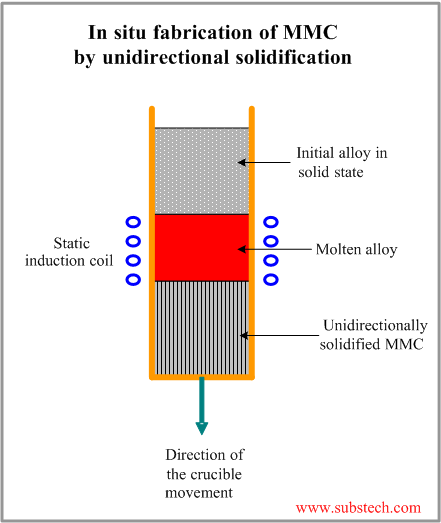to Composites
to Metal Matrix Composites
In-situ fabrication of Metal Matrix Composites
Dr. Dmitri Kopeliovich
In situ fabrication of Metal Matrix Composite is a process, in which dispersed (reinforcing) phase is formed in the matrix as a result of precipitation from the melt during its cooling and Solidification.
Different types of Metal Matrix Composites may be prepared by in situ fabrication method:
1. Particulate in situ MMC – Particulate composite reinforced by in situ synthesized dispersed phase in form of particles.
Examples: Aluminum matrix reinforced by titanium boride (TiB2) particles, magnesium matrix reinforced by Mg2Si particles.
2. Short-fiber reinforced in situ MMC – Short-fiber composite reinforced by in situ synthesized dispersed phase in form of short fibers or whiskers (single crystals grown in form of short fibers).
Examples: Titanium matrix reinforced by titanium boride (TiB2) whiskers,
Aluminum matrix reinforced by titanium aluminide (TiAl3) whiskers.
3. Long-fiber reinforced in situ MMC – Long-fiber composite reinforced by in situ synthesized dispersed phase in form of continuous fibers.
Example: Nickel-aluminum (NiAl) matrix reinforced by long continuous fibers of Mo (NiAl-9Mo alloy).
Dispersed phases of in situ fabricated Metal Matrix Composites may consist of intermetallic compounds, carbides, borides, oxides, one of eutectic ingredients.
Advantages of in situ Metal Matrix Composites:
- In situ synthesized particles and fibers are smaller than those in materials with separate fabrication of dispersed phase (ex-situ MMCs). Fine particles provide better strengthening effect;
- In situ fabrication provides more homogeneous distribution of the dispersed phase particles;
- Bonding (adhesion) between the particles of in situ formed dispersed phase and the matrix is better than in ex-situ MMCs;
- Equipment and technologies for in situ fabrication of MMCs are less expensive.
Disadvantages of in situ Metal Matrix Composites:
- Choice of the dispersed phases is limited by thermodynamic ability of their precipitation in particular matrix;
- The size of dispersed phase particles is determined by solidification conditions;
Unidirectional solidification of a eutectic alloy (alloy of eutectic composition) may result in formation of eutectic structure, in which one of the components has a form of long continuous filaments.
Scheme of a device for unidirectional solidification of in situ Metal Matrix Composite is shown in the figure:
Crucible with an eutectic alloy moves downwards (or alternatively the induction coil moves upwards). This movement results in remelting followed by resolidification of the alloy under controlled cooling conditions.
Value of heat transfer through the crucible bottom together with the crucible speed (v) and the power of the heating elements (induction coil) determine particular temperature gradient, which provides unidirectional solidification with flat solidification front.
The alloy acquires eutectic structure directed along the solidification direction with eutectic components in form of long mono-crystals (fibers).
A distance between the fibers (d) is determined by the solidification speed (v) according to the formula:
d² ~ v
to top
